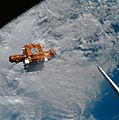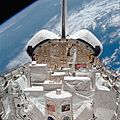STS-56 facts for kids
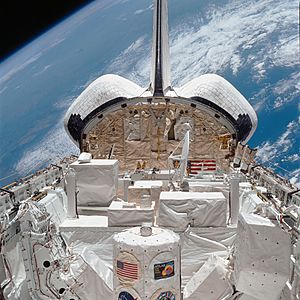
Components of the ATLAS-2 laboratory in the payload bay of Discovery
|
|
| Names | Space Transportation System-54 |
|---|---|
| Mission type | Scientific |
| Operator | NASA |
| Mission duration | 9 days, 6 hours, 8 minutes, 24 seconds (achieved) |
| Distance travelled | 6,202,407 km (3,853,997 mi) |
| Orbits completed | 148 |
| Spacecraft properties | |
| Spacecraft | Space Shuttle Discovery |
| Landing mass | 93,683 kg (206,536 lb) |
| Payload mass | 7,026 kg (15,490 lb) |
| Crew | |
| Crew size | 5 |
| Members |
|
| Start of mission | |
| Launch date | 8 April 1993, 05:29:00 UTC |
| Rocket | Space Shuttle Discovery |
| Launch site | Kennedy Space Center, LC-39B |
| Contractor | Rockwell International |
| End of mission | |
| Landing date | 17 April 1993, 11:37:19 UTC |
| Landing site | Kennedy Space Center, SLF Runway 33 |
| Orbital parameters | |
| Reference system | Geocentric orbit |
| Regime | Low Earth orbit |
| Periapsis | 291 km (181 mi) |
| Apoapsis | 299 km (186 mi) |
| Inclination | 57.00° |
| Period | 90.40 minutes |
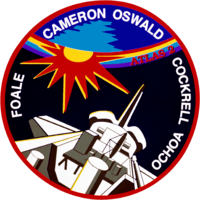 STS-56 mission patch 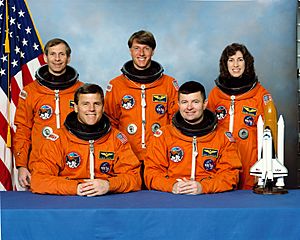 Standing: Kenneth D. Cockrell, C. Michael Foale, Ellen Ochoa Seated: Stephen S. Oswald, Kenneth D. Cameron |
|
STS-56 was a NASA Space Shuttle mission using the orbiter Discovery. This flight was launched from Kennedy Space Center, Florida, on April 8, 1993. The main goal of STS-56 was to carry out special scientific experiments in space.
Contents
Meet the STS-56 Astronaut Crew
The STS-56 mission had a crew of five brave astronauts. They worked together to complete all the science tasks in space.
| Position | Astronaut | |
|---|---|---|
| Commander | Second spaceflight |
|
| Pilot | Second spaceflight |
|
| Mission Specialist 1 | Second spaceflight |
|
| Mission Specialist 2 | First spaceflight |
|
| Mission Specialist 3 | First spaceflight |
|
Key Science Goals of the Mission
The STS-56 mission focused on understanding our planet and the Sun. The astronauts used special tools to gather important data.
Studying Earth's Atmosphere and the Sun
The main science project was called the Atmospheric Laboratory for Applications and Science-2 (ATLAS-2). This lab helped scientists learn about how the Sun's energy affects Earth's middle atmosphere. They also studied how these factors impact the ozone layer, which protects us from harmful sunlight.
ATLAS-2 had seven different instruments. Six of these were placed on a special platform in the shuttle's cargo bay. The seventh instrument was in two small containers on the cargo bay wall. These tools helped measure gases in the air and study the Sun's light.
Deploying a Free-Flying Satellite
On April 11, 1993, the crew used the shuttle's robotic arm, called the Canadarm, to release a small satellite. This satellite was named SPARTAN-201. It was designed to fly freely and study the solar wind and the Sun's outer atmosphere, called the corona.
SPARTAN-201 collected data on tapes. After two days, on April 13, 1993, the astronauts used the robotic arm again to grab SPARTAN-201 and bring it back into the shuttle.
Amateur Radio in Space
The crew also took part in the Shuttle Amateur Radio Experiment (SAREX II). They used amateur radio equipment to talk to schools around the world. This was a fun way to connect with students and share their experience in space.
During this mission, the astronauts even made a brief radio call to the Russian Mir space station. This was the first time a Space Shuttle and Mir connected using amateur radio. It was also the first time astronauts received live amateur television video from a ham radio club station on Earth.
Other Experiments on Board
Besides the main ATLAS-2 lab, the STS-56 mission carried other experiments. These included studies on how materials behave in space and how cosmic rays affect equipment. They also looked at how space affects living tissues, using a special experiment with rodents.
Another important tool was HERCULES, which helped astronauts take pictures of Earth. It allowed them to quickly find and target specific locations from space.
Images for kids



